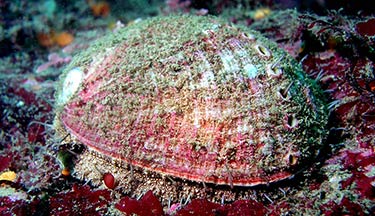Pāua to the People
 Paul Warren
Paul Warren
Paul’s Master’s thesis investigated pāua enhancement in Te Maunga o Mauao Mātaitai (reserve), his work being a collaborative project between Tauranga Moana Iwi Customary Fisheries Trust, Bay of Plenty Polytechnic and Te Whare Wānanga o Awanuiārangi.
Protection and enhancement of the kaimoana in the Mātaitai is a key priority especially in light of the Rena disaster, recent local oil spills and the planned dredging of the harbour and entrance channel. These cumulative impacts on Tauranga Moana require local iwi and hapū to be highly adaptable while maintaining kaupapa Māori and kaitiakitanga (guardianship).
Paul’s first step was to update abundance and distribution data for pāua which confirmed kaitiaki knowledge and indicated a steady decline in pāua numbers in the mātaitai over time. His research then examined the viability of reseeding using hatchery-raised pāua.
For this he employed a kaupapa Maori research framework with a mātauranga Māori foundation that utilized Western science as a tool for quantitative and qualitative methods, working collaboratively with all concerned groups to establish suitable areas for placement of the pāua. This collaboration involved an innovative combination of kaumātua knowledge with geographic information systems (GIS) analysis to establish a network of reseeding sites with optimal conditions throughout the mātaitai.
This approach successfully addressed the need for finding suitable habitat and allowed for tracking of multiple releases of juveniles at low densities. The difficulty in sourcing farmed juvenile pāua and the desire to preserve the whakapapa of local populations necessitated the development of Ahumoana a Toi Pāua Hatchery at Bay of Plenty Polytechnic (Toi Ohomai Institute of Technology).
This facility is now operational with broodstock (spawning adult pāua) in conditioning trials to improve their reproductive potential. An ongoing research programme into broodstock development and an annual reseeding strategy is underway, and these research threads involve second year students from the Marine Studies Diploma who assist in all aspects of the field and laboratory trials.
Further research into sexual maturation and fecundity of Tauranga Moana pāua was also undertaken. It is vital to understand how laboratory reared juveniles react to real world predators and these responses were also studied in the aquaculture facility. The results of these trials informed the design of innovative transport modules and predator exclusion cages which are used to enhance survival of juvenile pāua when released into the environment.
Effective collaboration between Māori and non-Māori researchers requires a fundamental paradigm shift from Western science as the dominant discourse and the use of techniques typically associated with Western science as tools for kaupapa Māori research were demonstrated effectively throughout Paul’s research.
The strong collaborations and multiple layers of this project describe a powerful suite of effective tools for contemporary kaitiakitanga in Tauranga Moana today.
Paul is well on his way to achieving his goals of improving the local kaimoana and interweaving traditional knowledge into this unique and evolving methodology.
